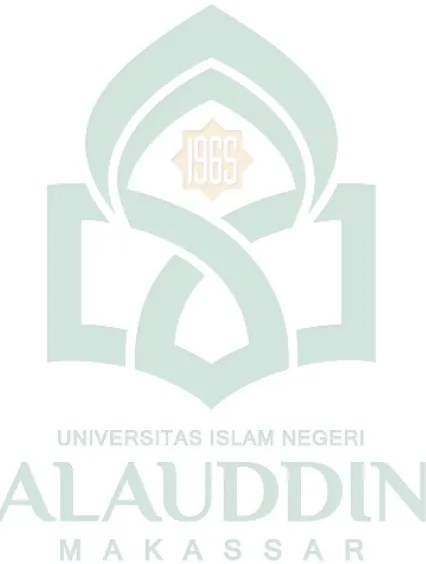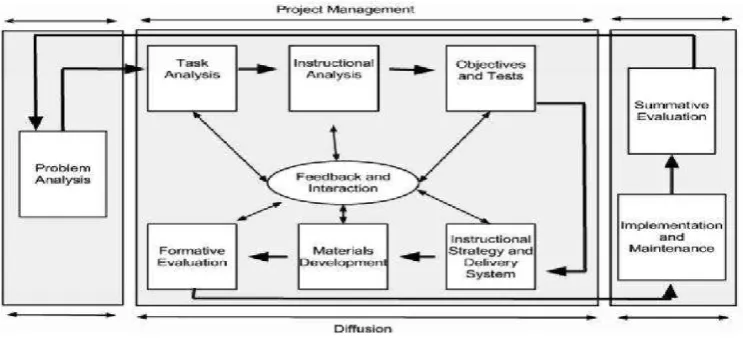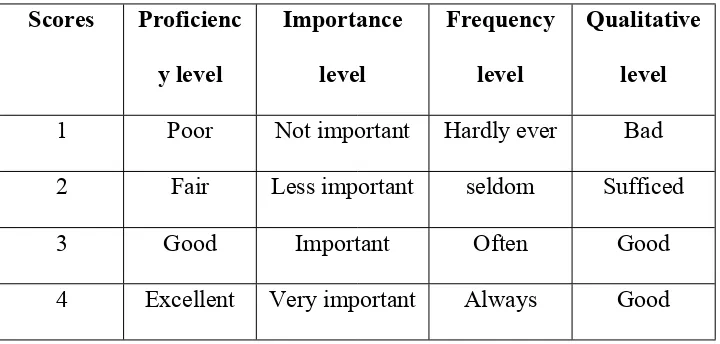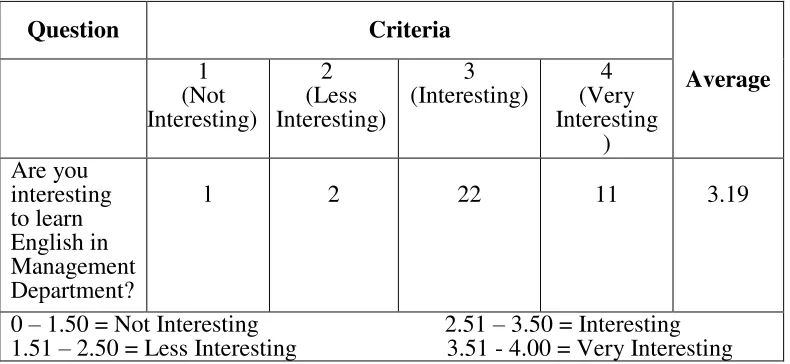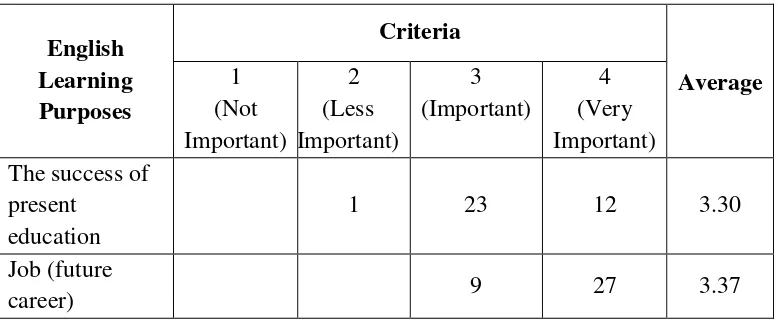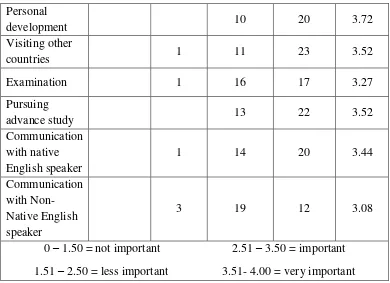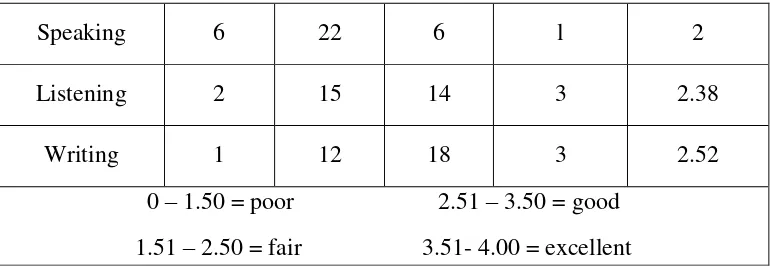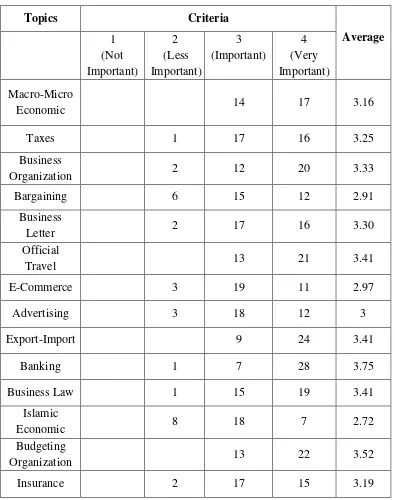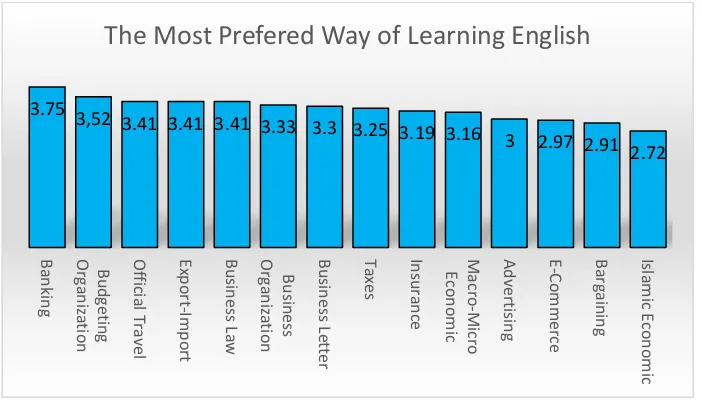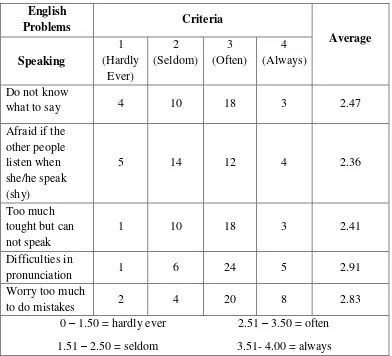i A Thesis
Submitted in Partial Fulfillment of the Requirements for the Degree of Sarjana Pendidikan (S.Pd) of English Education Department
Tarbiyah and Teaching Science Faculty Alauddin State Islamic University
of Makassar
By:
NURUL FATIH NASIR B Reg. Number: 20400113084
ENGLISH EDUCATION DEPARTMENT TARBIYAH AND TEACHING SCIENCE FACULTY ALAUDDIN STATE ISLAMIC UNIVERSITY OF MAKASSAR
ii Nama : Nurul Fatih Nasir B
NIM : 20400113084
Tempat/Tgl. Lahir : Rappang, 6 Juni 1995 Jurusan : Pendidikan Bahasa Inggris Fakultas : Tarbiyah dan Keguruan Alamat : Jln. Sultan Alauddin 4
Judul :“Developing English Materials for Students of Management Department: Business Organization & Taxes at STIE YPUP”
Menyatakan dengan sesungguhnya dan penuh kesadaran bahwa skripsi ini benar adalah hasil karya sendiri. Jika kemudian hari terbukti bahwa ia merupakan duplikat, tiruan, plagiat, atau dibuat oleh orang lain, sebagian atau seluruhnya, maka skripsi dan gelar yang diperoleh karenanya batal demi hukum.
Makassar, 23 November 2017 Penyusun,
v
ACKNOWLEDGEMENT
Alhamdulillah Rabbil Alamin, the researcher would like to express her deepest gratitude to the almighty Allah SWT., the only provider, the most merciful who gives His guidance, inspiration and good healthy for all time to conduct the writing of this thesis. Also shalawat and salam are always delivered to our great Prophet Muhammad SAW., who has brought us from the darkness to the lightness.
During the writing of the thesis, the researcher received much assistance from a number of people, for their valuable guidance, correction, suggestion, advice and golden support. Without them, the writing of this thesis would never been possibly completed. Therefore, the researcher would like to express the greatest thanks and appreciation for those people, especially to:
1. Prof. Dr. Musafir Pababbari, M.Si. The Rector of State Islamic University Alauddin Makassar.
2. Dr. H. Muhammad Amri, Lc., M.Ag. The Dean and all of the staffs of Tarbiyah and Teaching Science Faculty of Alauddin State Islamic University of Makassar.
4. The researcher’s consultants, Dr. Muhammad Yaumi, M.Hum., M.A and Sitti Nurpahmi, S.Pd., M.Pd., who have helped, guide, and supported the researcher during the writing of her thesis.
5. Dr. Andi Kaharuddin Bahar, S.IP., M.Hum. and Dr. Iriany Kesuma Wijaya, M.Pd. as my experts who have guided the researcher during the writing of her thesis.
6. All of the lecturers of Tarbiyah and Teaching Science Faculty of Alauddin State Islamic University of Makassar for their guidance during her study. 7. The researcher’s family especially her lovely father Muh. Nasir and her
beautiful mother Sumarni Wela.
8. Her brother Ilham Nasir, her younger brother Muhammad Akram, and her younger sister Nia Amalia, who always pray, encourage, educate and provide countless material supports, so that, she could finish writing and her study in UIN Alauddin Makassar.
9. The RnD group, the project team in this research; Muhammad Qurays, Moh. Zukri Prazetyo, Ichsan Ananta Wikrama, Nurfikriyah Irhasih, Riska, and Nurwahida for their sincere friendship and assistance during the writing.
11.The Racun Family, who always inspired and motivated her when she gave up.
12.All of the people around the researcher’s life who could not mention one by one by the researcher that have given a big inspiration, motivation, and spirit.
The researcher realizes that, this writing still not perfect. Remaining errors are the writer’s own; therefore, constructive criticisms and suggestions will be
highly appreciated. May all our/the efforts are blessed by Allah SWT. Amin.
The Researcher,
viii
PERNYATAAN KEASLIAN SKRIPSI ... ii
PERSETUJUAN PEMBIMBING ... iii
PENGESAHAN SKRIPSI ... iv
ACKNOWLEDGEMENT... . v
TABLE OF CONTENTS... viii
LIST OF FIGURES AND TABLES... x
LIST OF APPENDICES ... xi
ABSTRACT... xii
CHAPTER I INTRODUCTION ... 1
A. Background ... 1
B. Research Problems ……… 5
B. Research Objectives ... 5
C. Research Significance ... 6
D. Research Scope ……… ... 7
E. Operational Definition of Term ... 7
CHAPTER II REVIEW OF RELATED LITERATURES ... 9
A. Review of Related Research Findings ... 9
B. Theoretical Foundation…………... 11
C. Theoretical Framework…………... 14
CHAPTER III RESEARCH METHOD... 17
A. Research and Development Model ... 17
B. Research and Development Procedure ... 18
C. Research Subject ... 19
D. Types of Data ………... 19
E. Research Instruments ... 20
F. Data Collecting Procedures ... 20
G. Try Out ... 21
xi
CHAPTER V CONCLUSIONS AND SUGGESTIONS ... 84
A. Conclusions ... 84
B. Suggestions ... 85
BIBLIOGRAPHY ... 86
APPENDICES ... 88
x
FIGURE 2.The Seels and Glasgow ISD Model 2... 18
FIGURE 3.Procedures of Data Analysis Technique in Qualitative Miles and Huberman ... 23
TABLE 1. Catagories Scores... 25
TABLE 2. The Result of the First Question... 28
TABLE 3. The Result of the Second Question... 28
TABLE 4.The Result of the Third Question ………. 29
TABLE 5. The Result of the Fourth Question ……….. 30
TABLE 6. The Result of the Fifth Question ………. 31
TABLE 7. The Result of the Sixth Question ... 32
TABLE 8.1. The Result of the Seventh Question for Speaking Skill ……….... 34
TABLE 8.2. The Result of the Seventh Question for Listening Skill ………… 35
TABLE 8.3. The Result of the Seventh Question for Reading Skill ... 36
TABLE 8.4. The Result of the Seventh Question for Writing Skill ……...…. 37
TABLE 9. The Result of the Eighth Question for Reading Skill ……….. 37
TABLE 10. The Result of the Ninth Question for Speaking Skill ………. 38
TABLE 11. The Result of the Tenth Question for Listening Skill ... 39
TABLE12. The Result of the Eleventh Question for Writing Skill... 40
TABLE 13. The Result of the Students Need of Learning Sytles... 41
xi
xii
Appendix 1. Questionnaire Students’ Need Analysis... 88
Appendix 2. The Interview’s Guide for Students... 93
Appendix 3. The Transcript of Students’ Interview... 94
Appendix 4. Observation Sheet for Experts and Lecturer... 97
Appendix 5. The Learners’ Accpetability... 99
Appendix 6. Teaching Materials Design (Blueprint/SAP)... 101
Appendix 7. Lesson Plan... 123
Appendix 8. Product Design... 154
xiii
Year : 2017
Researcher : Nurul Fatih Nasir B
Consultant I : Dr. Muh. Yaumi M.Hum., M.A. Consultant II : Sitti Nurpahmi S.Pd., M.Pd.
1
Materials take an important part in teaching and learning process. Good and appropriate materials will give positive influence to the students’ learning process.
Many researchers offer developed English Materials for teaching. The materials include printed material, audio, visual, multimedia, internet, etc. those activities will give an impact to their and our futures as Allah SWT says in QS. Al-Mujadilah verse 11:
ۚ ٍتاَجَرَد َمْلِعْلا اوُتوُأ َنيِذهلاَو ْمُكْنِم اوُنَمآ َنيِذهلا ُهللَّا ِعَفْرَ ي
“….
Allah will raise those who have believed among you and those who were given knowledge, by degrees….”To conduct English learning material means aimed at support the students’ competence in English study program, so it should be based on the learners’
The use of inappropriate materials might prevent the students to develop their skills to communicate using English in the target situation of their field of works. If such condition happens, the purposes of the English teaching will not be achieved. Therefore, developing appropriate English learning materials for students of management department is necessary. Appropriate materials can help the students to learn English more easily. It is because they are learning useful materials that are related to their future job; materials that are suitable with their needs.
Based on the reasons above, the researcher decides to overcome those problems and develop the English materials for the English materials and worksheet by using English for Specific Purposes (ESP) and also using Instructional System Design (ISD) Model.
First is ESP. Hutchinson and Water stated that ESP as an approach rather than a product. It means that ESP does not involve a particular kind of language, teaching materials or methodology.1 In other words, ESP is an approach to language teaching which aimed to meet the needs of particular learners. In contrast, Dudley-Evans and St John give their modification based on their-self-understanding of ESP definition. They make a distinction between absolute characteristic and variable characteristic in ESP.2
Based on the English for Specific Purposes (ESP) tree of language teaching by Hutchinson and water’s, ESP has three kinds; English for Science and
1. Tom Hutchinson and Alan Waters, English for Specific Purposes: a Learning-Centered Approach (Cambridge: Cambridge University Press, 1987), pp.19.
Technology (EST), English for Business and Economics (EBE) and English for Social Sciences (ESS). In each kind, there are divided into two kinds; English for Academic Purposes (EAP) and English for Occupational Purposes (EOP). In English for Science and Technology, it consists of English for Medical Studies and English for Technicians. In English for Business and Economics, it consists of English for Economics and English for Secretaries. Meanwhile, in English for Social Sciences, it consists of English for Psychology and English for Teaching.
In addition, English lesson for the students of Management Department in this research named English for Accounting was included in English for Business and Economics. Moreover, with ESP, the goal of the lesson can be clearly for the students without involving a particular kind of language, teaching materials or methodology. This approach is called as an easy-going approach for teaching English especially for the first semester students of Management Department because with this approach, the students’ mind did not have to think greatly hard
and the lesson will be more specific.
The other way to solve the problem in this research the researcher is using ISD (Instructional System Design) model from Seels and Glasgow (1998) conclude that their model is quite similar to many others, it is based on the assumption that design and development take place in the context of project management.3
In this model, there are organized into three management phases: needs analysis management, instructional design management, and implementation and
evaluation management. As a conclusion, this model is used to develop the English materials especially in developing module because with utilizing all three phases in this model and focus to develop the materials lesson such as module whose created and adopted by clients and users.
In this research, the researcher developed a worksheet for students of Management Department. The researcher focuses in topics Business Organization and Taxes. Through this research, the researcher developed a new worksheet which can make the students of Management Department interest to study English. These topics will consist of a literature and a task.
To be much detail, in each topic consist of vocabulary which is relevant with the topics. The important thing that in this worksheet is integrated several English skills into each topic such as speaking, writing, reading and listening.
Refers from the explanation and being aware of the fact above, the researcher would like to take a research about the development of English materials for the first semester students of Management Department at STIE YPUP.
B. Research Problems
Based on the background, the main problems is a good development for Business Organization and Taxes topics based on the students’ need and students’ context. In order to enable the researcher should elaborate the main problem. There are three research problems should be formulated as follows:
2. What is the product of English materials development for students of Management Department in STIE YPUP?
3. How are the experts’ validation and students’ acceptability for the English language materials in Management Department at STIE YPUP?
C. Research Objectives
This study aims at developing English materials and worksheet for the topics Business Organization and Taxes for students of Management Department. The specific objectives of this research are:
1. To analyze the students need of English materials in Management Department at STIE YPUP.
2. To produce the English materials based on ESP (English for Specific Purposes) approach and ISD (Instructional System Design) model in Management Department at STIE YPUP.
3. To know the experts’ validation and students’ acceptability for the English language materials in Management Department at STIE YPUP.
D. Research Significance
1. Theoretical Significance
The theoretical significance from this research is expected to give more knowledge about English for students’ of Management Department through easily way for the students of Management department especially for Business Organization and Taxes topics.
This research would be beneficial for the students of Management Department, English lecturer and Management Department of STIE YPUP. First, for the students of Management Department; in the future, the result from this research can help the students of Management Department more easily to understand about the materials especially for each topic in the worksheet and implemented into their work, studies, and future. In the future the researcher hopes that the result of this research is the worksheet can be used as a guidebook.
Second, for the lecturer; the product that designed in this research can facilitate the lecturer to more easily teach English for the student of Management Department based on the students’ needs. Third, for Management Department of STIE YPUP; hope this product can be used as a worksheet for students’ of Management Department in learning and teaching process especially for the first semester students of Management Department.
E. Research Scope
(product-driven), the Bates model, the Nieveen model, and the Seels and Glasgow model (ISD models).4
In this research, the researcher developed a unit for Business Organization and Taxes with integrated English skill used ESP and also use ISD (Instructional System Design) model to develop the English materials for the next printed materials such as worksheet for this research.
In addition, due to the limitation of time and budgeting in finishing this research, the researcher conducted this research only into two phases. They are need analysis, instructional design materials and formative evaluation.
F. Operational Definition of Term 1. Development
Development is a process to make something new or change something that was existed. In this research, development means that make a change in the materials lesson such as printed materials. In addition, if in previous printed materials have problems, through this development, the problems can be solved.
2. English Material
English material consists of two words. First is English and second is material. English is an important language in this world. As we know, English is an international language which is used by people in this world for communication with the other people from the other countries. Not only for
communication but also, English is used in educational world such as in textbook for students. While material mean anything, which is used to help to teach language learner.
As a conclusion, English material is information or ideas for use in creating a book or anything which is used to help to teach language learner which consist of used English as a language in the book.
3. Business Organization
Business organization is association who consists of people who have a business. Business organization is a group of people who collaborate to achieve in certain commercial goals. In the other word, business organization is one or more business controlled in common by a person or group of people.
4. Taxes
9 CHAPTER II
REVIEW OF RELATED LITERATURE
This part centers around the study of some previous research findings on the related topics to the Business Organization and Taxes materials and the formulation of theoretical framework.
A. Review of Related Research Findings
Various researchers had conducted a research related to English materialsabout developing materials, exercises and about ESP (English for Specific Purposes). As a references from the previous research, the researcher present in this section. First is Ghozali. Ghozali conducted R&D to create English textbook for vocational high school. The conclusion from his research are designed textbook with using R&D is more effective to increase the students’ achievement in learning English and can increasing the quality of teaching English through improving the quality of the textbook.1
The second is Suyadi. Suyadi had conducted his research at a state university in Jambi Province. The aimed at his research is improving teaching English materials for accounting program which is needed for the student of accounting at university level. He found that the students of accounting program needs a specific material in learning English which has tight relationship with their study program. While English skills are need to be combined with the knowledge target
for accounting. Based on his finding Suyadi used ESP (English for Specific Purposes) to solve his problem in his research.2
In addition, the materials should follow the students’ current level of skills to avoid difficulties in adopting and transferring the ideas from the lesson materials from one language to another. The materials which the researcher will develop must match with the students needs. Because of that, the students can be more easily to understand the materials and the students will appreciate their time and they will effort to learn their materials.
The third is Safrizal. From his research, the conclusion is in several universities especially in Accounting Department, English subject in that university is taught as English General Purposes not English Specific Purposes. In addition, he found that teaching materials is designed by some criteria and also based on the students needs and supported by theories in ESP.3
The fourth is Ruth Hillis. In his research, he found that to developing instructional materials, should determine the procedures which will used in our development. The procedures are selecting the theme, setting up criteria to serve as a guide in preparation of new instructional materials and as a basis for evaluation, preparing first drafts of the materials, trying out the materials, and revising the materials for general use.4
2. Suyadi. ‘English for Specific Purposes for Accounting Students’. IJIRES. 2016. Vol.3, no. 1, pp.144.
3. Safrizal. ‘Designing ESP Teaching Materials for Students of Accounting Department of Al-Azhar University Medan’. Al-Azhar University Medan. 2013. pp. 97.
The fifth is Harsono. The conclusion from his research is developing teaching/learning materials for ESP is more demanded than that for general English because the availability of the ESP learning materials in public is very rare. In developing the ESP learning materials, the researcher can develop the teaching materials by applying the principles and procedures of language teaching materials including formulating the teaching objectives, adapting and or supplementing the existing materials, and or creating our own materials.5
Based on some previous finding research, the researcher concludes that to develop the materials and exercises, it must be based on learners needs. Developing printed materials especially through R&D can increase the students’ achievements and the qualities in the learning English particularly for printed materials which will use in the school or university.
In other side, developing printed materials with ESP (English for Specific Purposes) and ISD (Instructional System Design) can make the students more prepared to confront the real world occupation. The researcher developed new printed English materials to help the students to increasing their motivation to learn this material. So that, the target of SAP can achieve well.
B. Theoretical Foundation
Theoretical foundation is some theories which supporting this and relevant with our research. There are several theoretical foundations in this research about
developing materials, business organization, taxes, ESP (English for Specific Purposes) and ISD Model.
a. Developing materials. According to Tomlinson as cited in his second edition book, materials development is both a field of study and a practical undertaking. As a field it studies the principles and procedures of the design, implementation and evaluation of language teaching materials.6
In other word, materials development refers to anything which is done by writers, teacher or learners to provide sources of language input and to exploit those sources in ways which maximize the likelihood of intake and to stimulate purposeful output.7 Materials developers might write textbooks, tell stories, bring advertisements into the classroom, express an opinion, provide samples of language use or read a poem aloud.
b. English material is information or ideas for use in creating a book or anything which is used to help to teach language learner which consist of used English as a language in the book.
c. Business Organization
Business organization is association who consists of people who have a business. Business organization is a group of people who collaborate to achieve in certain commercial goals. In the other word, business
6. Brian Tomlinson, ‘Materials Development’ in R. Carter and D. Nunan (eds), The Cambridge Guide to Teaching English to Speaker of Other Languages (Cambridge: Cambridge University Press, 2001), pp.66.
organization is one or more business controlled in common by a person or group of people.
d. Taxes. Taxes are generally an involuntary fee levied on individuals or corporations that is enforced by government entity, whether local, regional or national in order to finance government activities.
e. ESP (English for Specific Purposes). Hutchinson and Waters see ESP as an approach rather than a product, by which they mean that ESP does not involve a particular kind of language, teaching materials or methodology.8 In other side, Dudley-Evans and St John said that ESP is divided into two absolute and variable characteristic.9
Based on absolute characteristic, ESP is defined to meet specific needs of the learner; makes use of the underlying methodology and activities of the discipline it serves; and centered on the language (grammar, lexis, and register), skills, discourse and genres appropriate to these activities.
While based on variable characteristic, ESP may be related to or designed for specific disciplines; may use, in specific teaching situations, a different methodology from that of general English.
ISD Model. ISD model is acronym from instructional system design. ISD model was presented by Seels and Glasgow. They are compare their model to several others and generic ADDIE framework. Seels and
8. Tom Hutchinson and Alan Waters, English for Specific Purposes: a Learning-Centered Approach (Cambridge: Cambridge University Press, 1987), pp.19.
Glasgow emphasized the steps within each phase in this model may be conducted in a linear fashion, but often are not, although the three phase are generally considered to be self-contained and linear.
C. Theoretical Framework
The problem faced by the students of Management Department in learning English is the difficulties to understand the lesson because the materials using English for general purposes not English for specific purposes.
Because of that, in this research, the researcher try to offer a new way by designing English materials for students of Management Department by creating a new English material and worksheet with ESP and ISD Model to achieve the objective of learning in the SAP.
By designing it, the researcher expects in the learning and teaching process, the students of Management Department can more easily to understand the lesson than before, the teacher has a textbook as a model and the objective of the learning achieved.
The theoretical framework underlying this research is presented in the following diagram:
ESP
(English for Specific Purposes)
Printed Materials (Worksheet) of
Bussiness Need Analysis
Materials Design Evaluation (Formative Evaluation)
ISD Model (Instructional System Design) EAP (English for Academic Purposes) EOP (English for
Figure 1. Theoretical Framework
In this research the researcher developed English material such as worksheet for students of Management Department in topics Business Organization and Taxes. The researcher used English for specific purposes (ESP) and Instructional System Design (ISD) model in this research. ESP was used as an approach to integrated English for the other lesson in the other major such as in management department. Through ESP, the researcher used three steps. They were need analysis, materials design and formative evaluation. While ISD (Instructional System Design) model was used as an instructional design for design the printed material as worksheet.
17
This chapter discusses about research and development method of this
study. It includes research method, development model, research subject, types of
data, research instrument, data collecting procedure, try-out of product, and data
analyzing technique.
A. Research and Development Model
Based on the purpose of this study, the research design was Research and
Development (R&D). There were some models which could be applied by the
researchers especially for product oriented model such as The Bergman and
Moore Model, The de Hoog, de Jong and de Vries Model, The Bates Model, The
Nieveen Model and ISD Model. Based on those models stated previously, the
researcher adopted ISD model by Seels and Glasgow. In addition, this model
similar to ADDIE model as the result, this model was very useful having stages
clearly defined which makes implementation and instructions effectively.
The ISD model is acronym of Instructional System Design. This model
consists of three phases: needs analysis, instructional design, and implementation
and evaluation.
The researcher only used two phases: needs analysis and instructional
analysis because the researcher had a limited time and limited budgeting to
Figure 2.The Seels and Glasgow ISD Model 2: For Practioners
The first phase was needs analysis. The aim of this phase was to find out
the needs assessment (goals), performance analysis (instructional
requirements), and context analysis (constraints, resources, and learner
characteristic). The second phase was instructional design includes all steps
related to design, development, and formative evaluation. The third phase was
formative evaluation. This phase was done by the researcher to know the
experts’ validation and the students’ acceptability.
B. Research and Development Procedures
The procedures in developing Business Organization and Taxes based on
ISD model which provided 3 phases in terms of need analysis, instructional
design and formative evaluation.
1. Need analysis
First phase is need analysis includes all of the decisions associated
with conducting need analysis and formulating a management plan. These
requirements), and context analysis (constraints, resources, and learners
characteristics).
2. Instructional Design
Second phase is instructional design, indicated by double-ended
arrows connecting each of the six steps with a central oval labeled,
feed-back and interaction. Completion of phase two occurs after satisfactory
results are obtained from formative evaluation.
3. Formative Evaluation
Phase three is implementation and evaluation includes preparing
training material, creating support structures, doing a formative evaluation
by concluding the questionnaire and try-out, and disseminating
information about the project.
C. Research Subject
The subject that researcher used in this research was the third semester
students of Management Departments at STIE YPUP Makassar. The researcher
used two classes in the university. The first class was as a control class and the
second class was as an experimental class. Each class consisted of 50 students: 25
male students and 25 female students.
D. Types of Data
The types of data in this research were qualitative and quantitative data.
gathered from the result of questionnaire and from the try-out. The other sources
type of data was quantitative data. Quantitative data gathered from the results of
questionnaires which were answered by the students of Management Department
of STIE YPUP that consisted of 14 topics in Management lesson as need
assessment and also from the result of try-out were used by the researcher to find
out the effectiveness of printed materials (worksheet).
The result of the preliminary research and try-out were validated by the
experts to know the experts’ validation and the students’ acceptability about the
English language materials and worksheet was developed by the researcher.
E. Research Instruments
In this research, the researcher used two kinds of instruments. They were
questionnaire and rubric for expert. In addition, the questionnaire used to identify
the learners’ needs. The questionnaire was given to students of Management
Department to conduct need analysis. The question dealt with students of
Management Department need points with the need to construct the English
materials for students of Management Department and observation sheet were
addressed to the expert such the English lecturer at STIE YPUP and the expert
judgment.
F. Data Collecting Procedures
The data collection procedures in this research began from the researcher
to Management Department for the research subject or students. The researcher
asked the students to answer the questionnaire during 30 minutes. After that, the
researcher collected the questionnaire from the student. The results from the
students’ questionnaire about the topics were the next topics for the next printed
materials (worksheet) which were developed by the researcher in this research.
After determine several topics, the researcher developed the printed materials
through two phases: need analysis and instructional design.
Furthermore, the researcher conducted a pre-validation and past-validation
after the researcher conduct the first try-out toward the expert content namely
English lecturer in Management Department and instructional design expert
namely educational technology lecturer. The last phase was analyzing the data
through formative evaluation to determine the experts’ validation and the
students’ acceptability.
G. Try-Out
1. Try-Out Design
The try out design in this research means that the product which was been
try-out to the target subjects in the real learning and teaching situation in order to
evaluate the quality of the development materials and exercises. Thus, from this
try out, the main benefit which the researcher got was the researcher find out how
far the materials fulfill for students’ needs. Furthermore, in this phase, the
2. Try-Out Subject
The subject of this research was the new students of Management
Departments at STIE YPUP. In other word, the try out subject in this
research was the first semester of students of Management Departments at
STIE YPUP Makassar at academic year 2016/2017. The researcher used
two classes in the university. The first class was as a control class and the
second class was as an experiment class. Each class consisted of 50
students: 25 male students and 25 female students. The class was
dominated with Flores students.
H. Data Analyzing Technique
In this research, the researcher used mix method. It consists of qualitative
analysis and quantitative analysis technique to analyze the data. The data obtained
from the students were analyzed qualitative. The data from the students became an
attachment and notes for the researcher in developing materials in the form of
description of the products, comments, notes and suggestions. Next, the
quantitative analyzed data obtained from questionnaire students need analysis and
experts observation sheets. The result from the data became an attachment and
notes for the researcher in developing materials in the form of description of the
products, comments, notes and suggestions.
1. Qualitative Analysis
The data analysis technique in this research followed several steps by
qualitatively consists of three procedures. First is data reduction. Second
is data display. Third is conclusion drawing/verification.1
The data analysis technique in qualitative by Miles and Huberman was
presented in the following diagram:
Figure 3. Procedures of Data Analysis Technique in Qualitative by
Miles and Huberman
a. Data Reduction
In this phase, the researcher referred to obtain the mass of
qualitative data which was obtained through content expert and
instructional experts’ interview. In other word, this phase replaced all
irrelevant information based on experts’ judgment.
b. Data Display
This phase contained of the conclusions from the mass of data
which draw in the form of tables, charts, networks and other graphical
format. This was a continual process, rather than just one to be carried
out at the end of the data collection.
1
c. Verification and Conclusion Drawing
In this phase, our analysis should allow us begin to develop
conclusion regarding our study. These initial conclusions can be
verified, that was their validity examined through reference to our
existing field notes or further data collection.
2. Quantitative Analysis
In gathering information from students and experts the researcher
used the need analysis questionnaires and observation sheets. Types of
questions are linguistic needs and learning needs used for assessing
whole needs of the target. The categories of question are:
a. Introduction (personal information and perceptions on the need
of speaking course avaliability).
b. Linguistic needs (abilities: students’ level of proficiency,
priorities: language items that considered the most important to
learn).
c. Learning needs (problems: weakness and difficulties in
learning), and attitudes: participants’ feeling toward elements
of programs.
d. Experts’ observation sheets.
The proficiency score, the importance score, the frequency
score and the qualitative score of linguistic needs and learning
needs are derived by giving each category scores from one to four
Table 1.Categories Scores
Scores Proficienc
y level
Importance
level
Frequency
level
Qualitative
level
1 Poor Not important Hardly ever Bad
2 Fair Less important seldom Sufficed
3 Good Important Often Good
4 Excellent Very important Always Good
The researcher used the formula below as the quantitative data technique:
x =
∑∑fxf
Explanation:
= Mean Score
x
∑f= Frequency
Number of Respondents ∑fx =
The mean score of the respondents’ perceptions and expectation
toward students’ need of English material were then described by the
following scale:
1. Refers to 0 – 1.50
2. Refers to 1.15 – 2.50
4. Refers to 3.51 – 4.00
To clarify the data presentation, some data were analyzed by
using diagrams to see the distribution of the level of the frequency and
the important level of using language skill.
The overall data are then analyzed to recognize the needs inventory
of the target group in language learning which is then used as the basis for
formulating aims and objectives of learning and designing syllabus of
27
A. The English Materials Needed by The Students of Management Department
1. Description of the Students
The researcher made a research which had been held at STIE YPUP Makassar in M.K 2.2, Management Department. This class consists of 23 females and 13 male students as respondent. The researcher entered to the class to give a questionnaire for the respondents.
2. Description of the Students Need
a. The Data on the Students Need Obtained Through Questionnaire
The researcher gave a questionnaire to respondent in order to know what the students need in English materials for Management Department. The researcher gives a questionnaire to the respondent which consists of 12 questions, where the results further describes the students need for English materials in their department.
The researcher used the formula below to analyze the data from the questionnaire:
Explanation:
𝑥
=
Mean Score∑f = Frequency
∑ 𝑓𝑥 = Number of Respondents
After analyzing the questionnaire, the researcher can inform the result by the table below:
Table 2.The Result of the First Question
Question Criteria
Average 1
(Not Interesting)
2 (Less Interesting)
3 (Interesting)
4 (Very Interesting
) Are you
interesting to learn English in Management Department?
l 2 22 11 3.19
0 – 1.50 = Not Interesting 2.51 – 3.50 = Interesting 1.51 – 2.50 = Less Interesting 3.51 - 4.00 = Very Interesting
The information about the students’ interest to learn English in
Management Department was presented in table 2. Table 2, illustrated that the position of the total average score (3.19) refers to the interesting category, it described that most of the students in Management Department were interested in learning English.
Table 3.The Result of the Second Question
Question Criteria
Average
Table 3 describes the students’ perception about the importance to learn
English in Management Department. From the students’ perception, it was found
that learning English was very important in Management Department with average score 3.77.
The table below showed the result of the third question:
Table 4.The Result of the Third Question
English The success of
present education
1 23 12 3.30
Job (future
Personal English speaker
1 14 20 3.44
Based on the data presented in table 4, it was found that there were three main purposes of the students of Management Department in learning English; they are personal development (3.72), visiting other countries (3.52), and pursuing advance study (3.52). The purposes categorized as very important according to the level of importance score category.
The fourth question was about the students’ need of linguistic. The table below shows the result of the fourth question:
Table 5.The Result of the Fourth Question
Speaking 6 22 6 l 2
Listening 2 15 14 3 2.38
Writing 1 12 18 3 2.52
0 – 1.50 = poor 2.51 – 3.50 = good 1.51 – 2.50 = fair 3.51- 4.00 = excellent
The result in table 5 shows that most of the students thought that, their ability in reading and writing were in the good level which the highest average score are 2.61 and 2.52. Then, their ability in listening and speaking were in the fair level which the lowest average score are 2.38 and 2.
This table below shows the result of the fifth question: Table 6.The Result of the Fifth Question
English Skill Components
Criteria
Average 1
(Not Important)
2 (Less Important)
3 (Important)
4 (Very Important)
Reading 20 16 3.45
Speaking 3 9 23 3.51
Listening 1 1 14 19 3.33
Writing 2 13 19 3.30
0 – 1.50 = not important 2.51 – 3.50 = important 1.51 – 2.50 = less important 3.51- 4.00 = very important
Table 6 shows that most of the students thought that the fourth English language skills were important but learning Speaking was the most important skill with the score 3.46.
The table below shows the result from the sixth question: Table 7.The Result of the Sixth Question
0 – 1.50 = not important 2.51 – 3.50 = important 1.51 – 2.50 = less important 3.51- 4.00 = very important
Table 7 shows that the topics which used as English materials for students of Management Department. The English material topics had average score range from 2.51 to 4.00. The topics could be listed according to the level of importance as follows:
Chart 1.The Most Prefered Way of Learning English
According to the chart all of the topics were important and very important for new English materials and worksheet. The result from the analysis was aimed as a foundation for developing English materials and worksheet for students of Management Department who constructed by the researcher.
The seventh question was about the students’ learning need. The table below shows about the result of analysis from the seventh question.
3.75
Table 8.1.The Result of the Seventh Question for Speaking skill
English
Problems Criteria
Average tought but can not speak
1 10 18 3 2.41
Difficulties in
pronunciation 1 6 24 5 2.91
Worry too much
to do mistakes 2 4 20 8 2.83
0 – 1.50 = hardly ever 2.51 – 3.50 = often 1.51 – 2.50 = seldom 3.51- 4.00 = always
The data on table 10 was the result of the problems analysis faced by the students in speaking. All of the learning problems faced by the students in
speaking were categorized as “often” because all of the problems were in the
average score range from 2.36 to 2.91.
Table 8.2.The Result of the Seventh Question for Listening Skill
English
Problems Criteria
Average what they listen
1 10 21 3 2.66 sound which is similar
categorized as “often” with the average score range from 2.66 to 2.4. It means that
Next analysis was from reading skill. The table below shows the result from the difficulties in reading.
Table 8.3.The Result of the Seventh Question for Reading Skill
English Problem Criteria
Average Reading
1 (Hardly
Ever)
2 (Seldom)
3 (Often)
4 (Always
) Less the
vocabulary 2 2 26 5
2.88
Difficulty in understanding the meaning from the text
2 9 18 7 2.83
The text is too long 2 7 17 9
2.86
0 – 1.50 = hardly ever 2.51 – 3.50 = often 1.51 – 2.50 = seldom 3.51- 4.00 = always
From the data presented in the table 8.3 there were three problems faced by the students in reading. All of the learning problems faced by the students in reading were often because all of the problems average score range from 2.83 to
2.88 which mean ‘often’ occurred when the students reading English.
Table 8.4.The Result of the Seventh Question for Writing Skill
English Problem Criteria
Average
Difficulty to get an
idea 1 6 20 8
The data in table 8.4 was the result of the problems analysis faced by the students in writing. All of the learning problems faced by the students in writing
occurred with “often” frequency. All of the problems were in the average score
ranging from 2.91 to 3.05.
The eighth was about the students’ learning need of methodology. This table below shows the result of the eighth question:
Table 9.The Result of the Eighth Question for Reading Skill
Read faster
Based on the data presented in table 9 there were two techniques that the students of Management Department had to choose they were read faster and intensive reading. Both of the techniques refers to important category with the average scores 3.05 and 3.30.
The table below shows the result of the ninth question. Table 10.The Result of the Ninth Question for Speaking Skill
students’ learning need of methodology in speaking skill was in the “important
level”.
The table below shows the result from the students’ learning need of methodology in listening skill.
Table 11.The Result of the Tenth Question for Listening Skill
Learning
Referring to table 11, there were four techniques that the students have to choose they were listening and writing (3.66), watching video (3), filling in the blank based on audio (3.27), and guessing picture (3.25).The result of the data analysis indicated that the students preferred learning listening through listening and writing. They were the most approptiate way for the students to learn listening of English and it was in the “very important level”.
Table 12.The Result of the Eleventh Question for Writing Skill
arrange words achieved the highest average score (3.41)
1) Need inventory
a) Reviewing Needs Inventory from the Linguistic Needs
Identifying linguistic need was carried out by analyzing the students learning ability and learning priorities. The result of the analysis was used for prioritizing the components of integrated skill and selecting appropriate teaching materials which are required to design the English material.
1. Learning Ability
The process of identification was first of all carried out by
analyzing the students’ learning ability in English material.
Learning ability was measured based on the results of analysis of
the students’ proficiency level in the area of the integrated skill
such as speaking, writing, reading, and listening. The result of
analysis indicates that the students’ proficiency level of all the
integrated skill ranges around level “Goodand Fair “as indicated in the following average scores achievement.
Table 14.The Result of the Students Learning Ability
No Skills Average score Proficiency
Level
1 Reading 2.61 Good
2 Writing 2.52 Good
3 Listening 2.38 Fair
Even if the students speaking skill average score was felt fair, the lecturers should not give priority to this component due to the
students’ tendency to have less attention to learn speaking skill in
English material. However, speaking may not totally be ignored in the English material. The lecturers should prioritize writing and reading in teaching English material and strengthened out the speaking skill after English material practices in the classroom.
2. Learning Priorities
Determining learning priorities was conducted by analyzing
the respondents’ perceptions on their leaning problems of the
integrated skill such as speaking, reading, writing, and listening. The results of the analysis recognized as follows:
Table 15. The Result of the Students Learning Priorities
No Skills Average score Proficiency
Level
1 Speaking 3.47 Important
2 Reading 3.45 Important
3 Listening 3.35 Important
The findings above illustrate that the material designed need to give four priorities; (1) speaking, (2) reading, (3) listening, and (4) writing.
3. The Need for Learning Integrated Skill
Integrated skills were the items conducting of English materials which have been the priorities to learn with regard to learning the integrated skill, almost all respondent think it was very important to learn English material by enriching the students English comprehension for Management comprehension from topics that related with their vocational with average score between 2.51– 4.00. Fourteen topics were then selected based on the analysis of the respondent perception according to the level of importance as follows: Table 16.The Result of the Level of Importance of the English Materials
Topics and Worksheet
No Topics Average score Importance level
1 Banking 3.75 Very important
2 Budgeting Organization 3.52 Very important
3 Official Travel 3.41 Important
4 Export-Import 3.41 Important
5 Business Law 3. 41 Important
6 Business Organization 3.33 Important
7 Business Letter 3.30 Important
8 Taxes 3.25 Important
9 Insurance 3.19 Important
11 Advertising 3 Important
12 E-Commerce 2.97 Important
13 Bargaining 2.91 Important
14 Islamic Economic 2.72 Important
Conclusively, all the topics of English material and worksheet as listed above included since they are considered important or very important for the students to be learnt in English course at the Management Department study program.
Table 17. The Overall Needs Inventory from Linguistic Needs
Linguistic Needs
1. Fair in speaking 2. Fair in listening 3. Good in writing 4. Good in reading
1. Speaking is the first priority 2. Reading is the second priority 3. Listening is the third priority 4. Writing is the fourth priority
Learning English Language in Management from the Topic
1. Banking
2. Budgeting Organization 3. Official Travel
4. Export-Import 5. Business Law
6. Business Organization 7. Business Letter
8. Taxes 9. Insurance
10.Macro-Micro Economic 11.Advertising
12.E-Commerce 13.Bargaining
b) Reviewing Needs Inventory from the Learning Needs
The students learning needs in this study were identified by analyzing the students learning problems and learning attitudes. The
students’ learning problems were described based on the analysis of
the respondents’ perceptions on the obstacles to the students learning
success to be able to effectively in English comprehension. While to
explain the students’ attitude, the researcher analyzed the students’
learning preferences and learning styles based on the respondents’
perceptions since these two factors were believed able to affect the
students’ attitudes in learning.
1. The Students’ Learning Problems
Based on the analysis of the respondents’ perceptions on
the students’ learning problems, it was founded that the students learning difficulties can apparently stem from many causes. These include:
a. Problems in Speaking such as do not know what to say, afraid if the other people listen when she/he speak, too much thought but cannot speak, the difficulties in pronunciation, and worry too much to do mistakes. b. Problems in Listening such as difficulty in receive a
which is similar, and the situation and condition which is not right.
c. Problems in Reading such as less the vocabulary, difficulty in understanding the meaning from the text, and the text is too long.
d. Problems in Writing such as difficulty to get an idea, fixated on the using of grammar/structure, and less the vocabulary.
2. The Students’ Learning Attitudes
It has already been stated that learning attitudes are analyzed to discover what the students like to learn. For the reason, the focus of this discussion deals with identification of the learning preferences and styles in learning English materials in Management Department based on the
respondents’ perceptions.
3. The Students’ Learning Preferences
The students’ learning preferences in English course were
specially focused on describing the students’ preferences in
to learning listening by listen and write, watching video, fill in the blank based on audio, and guess picture. The last, the students prefer to learning writing by write reports, developing the main idea, formal and informal letters, and last making up arrange word or paragraph.
4. The Students’ Learning Styles
The results of the data analysis associated with the
students’ learning styles indicate that the students at the
management department study program can mostly be categorized as communicative and concrete students:
a. Learning English by doing task b. Learning English by talking in pairs c. Learning English by self learning d. Learning English by picture e. Learning English by large group f. Learning English by small group g. Learning English by movies and videos
Table 18. The Overall Needs Inventory from Learning Needs Learning Needs
The Learning Problems The Learning Attitudes 1. Problems in Speaking
Do not know what to say
Afraid if the other people listen when she/he speaks.
Too much thought but cannot speak, the difficulties in pronunciation.
Worry too much to do mistakes. 2. Problems in Listening
Difficulty in receive a message from what they listen.
Difficulty in understanding a speaker.
Difficulty in distinguish a sound which is similar.
The situation and condition which is not right.
Learning Preferences
Learning Speaking Techniques report back. Simulation and interview.
Learning Reading Read faster. Intensive reading. Learning listening
Listen and write. Watching video
Fill in the blank based on audio Guess picture.
Learning writing Write reports
3. Problems in Reading Less the vocabulary.
Difficulty in understanding the meaning from the text. The text is too long. 4. Problems in Writing
Difficulty to get an idea. Fixated on the using of grammar/structure.
Less the vocabulary.
Learning Styles
1. Learning English by doing task 2. Learning English by talking in
pairs
3. Learning English by self learning
4. Learning English by picture 5. Learning English by large group 6. Learning English by small group 7. Learning English by movies and
videos
b. The Data Obtained Through Interview Guide
The interesting in learning English is very important because it
could increase the students’ motivation when they learnt. An example
of why learning English is interested because it is challenging to be learnt. This reason is supported by some followed statements:
As followed from Mutiarasani statement:
I choose very interested because in my opinion, first I like to learn English although I have not mastered it. Second, because English is related to my major; Management.1
The second came from Cici by supporting Mutiarasani statement:
I am interested because at the end of my study I will enter the business world so I must master English in order to go abroad so that I could interact with new people.2
Additional statement which interested in learning English is very important because it is very important to learn English. As followed
from Riska’s statement:
I believe with learning English, it will help me a lot for my future job.3
The importance level of learning English is variated. In management department for example, most of the student see English is very important because it could help the students whether to increase their knowledge or implement it for their future job. All of these reasons were proved in followed statement:
1.
(Mutiarasani, 2nd semester of student of Management Department of STIE YPUP Makassar, interviewed on June 15th, 2017)
2.
(Cici, 2nd semester of student of Management Department of STIE YPUP Makassar, interviewed on June 15th, 2017)
3.
As followed in Mutiarasani statement:
It is very important to learn English because there will be some materials or objects that contained English in Management Department whether in learning program or job environment.4
Supporting Mutiarasani statement, Cici stated that:
Learning English is very important because we need to learn and understand it for operate some programs that using English which related for my future job.5
The last statement came from Riska, she stated that:
We should master English if we want to work in Management major, especially in marketing Management.6 To be much concerned why learning English is important, it will guide to several aims for future planning. English could be used as the media to communicate or it could be a reason to get a job easily. These aims are proved by followed statements:
Mutiarasani wants to learn English so that she can get a job someday, as proved in her statement:
By mastering English, it would be easier to get a job.7
Addition for Mutiarasani statement, Cici thought that mastering English could also help her to achieve her dream which she want to go abroad. As stated in her statement:
4. (Mutiarasani, 2nd semester of student of Management Department of STIE YPUP Makassar, interviewed on June 15th, 2017)
5.
(Cici, 2nd semester of student of Management Department of STIE YPUP Makassar, interviewed on June 15th, 2017)
6.
(Riska, 2nd semester of student of Management Department of STIE YPUP Makassar, interviewed on June 15th, 2017)
7.
Get success in education is good for now, we can get some achievement. If I and my friends keep improving to master English, it will be easier to get a job someday, moreover in accounting. We also can continue our magister in abroad, because I myself dreamed to visit many countries, do business with many people and get success.8
Different with Mutiarasani and Cici statement, Riska gave more focuses on her Speaking improvement. As stated in her statement:
If I mastered English, someday I could speak with tourist as well as I could also promote my products on the field.9
The four skills that integrated with English language competence are very important to be learnt. Students sometimes found difficulties in vocabulary or speaking. Although students found some obstacles when they learnt it, but they still have one favorite skill as motivation to keep learning English. This is proved by followed statements:
I think it is very important because if you cannot read English correctly, you will get problems in the meaning. Moreover, if you
don’t master English you will difficult when speak with native
speaker. So, all skills are very important, it’s all related each other.10
In my opinion, it is very important to master all the skills. I love learning English since childhood, even if I have not mastered it well but I try to master it until the completion of my study so that I can be success in the future. The importance of Reading skill, if we read some paragraph in English, the way it was written is different when we read it. When we can read it correctly it will be good, but when we do not know how to read it correctly people will be laughed because the missed-meaning. Speaking skill is also important because some word in Indonesia is different with
English, for example the “R” word. That’s why learning Speaking
8.
(Cici, 2nd semester of student of Management Department of STIE YPUP Makassar, interviewed on June 15th, 2017)
9.
(Riska, 2nd semester of student of Management Department of STIE YPUP Makassar, interviewed on June 15th, 2017)
10.
skill is important in order to speak like a native speaker. Listening skill is important to be learn too, because we can found some obstacles in what we hear with what we write because of less ability, so I think all skills are very important.11
The four skills in English are very important. The skill that I like most is Reading, because I love to read even I have not master English yet.12
The obstacle that students got in learning English was lack of vocabularies. That is why with adding vocabularies will help the students to learn English well. This reason approved in followed statement:
I think vocabularies should be served in each topic. It will be better if we required memorizing the vocabulary that related with the lesson to increase the vocabulary.13
That is good if there is vocabulary in each topic, it will help us to understand the lesson.14
With the help of the vocabularies, it would help us to add more vocabularies comprehension that related with our vocational; Management.15
a. The Result of English Materials Development 1. Conceptual Map
The implementation of the overall procedures of English language competence is conducted by an idea of formulating a conceptual
11. (Cici, 2nd semester of student of Management Department of STIE YPUP Makassar, interviewed on June 15th, 2017)
12. (Riska, 2nd semester of student of Management Department of STIE YPUP Makassar, interviewed on June 15th, 2017)
13.
(Mutiarasani, 2nd semester of student of Management Department of STIE YPUP Makassar, interviewed on June 15th, 2017)
14.
(Cici, 2nd semester of student of Management Department of STIE YPUP Makassar, interviewed on June 15th, 2017)
15.
framework for English language competence based on syllabus. The conceptual framework illustrates the key elements which underline the syllabus content.
Figure 4. A Framework for English Language Competence based Syllabus In order to create learning opportunities based on students need, the syllabus must be contains of three main pedagogical procedures i.e:
a. Providing Language Skill
